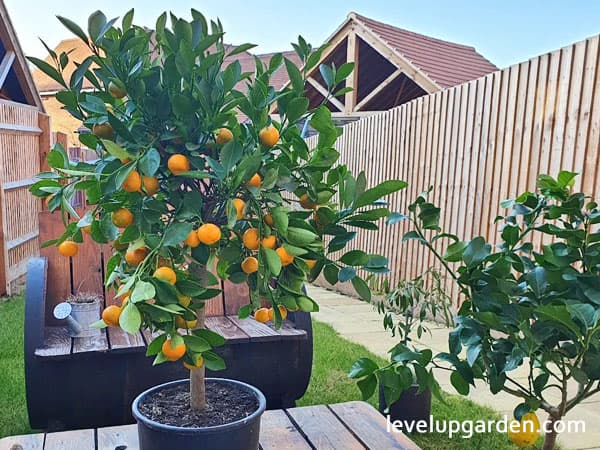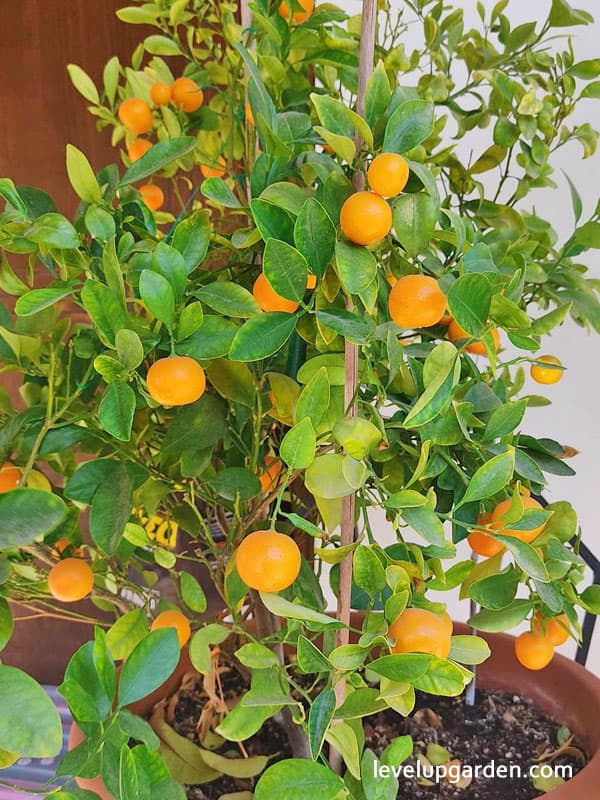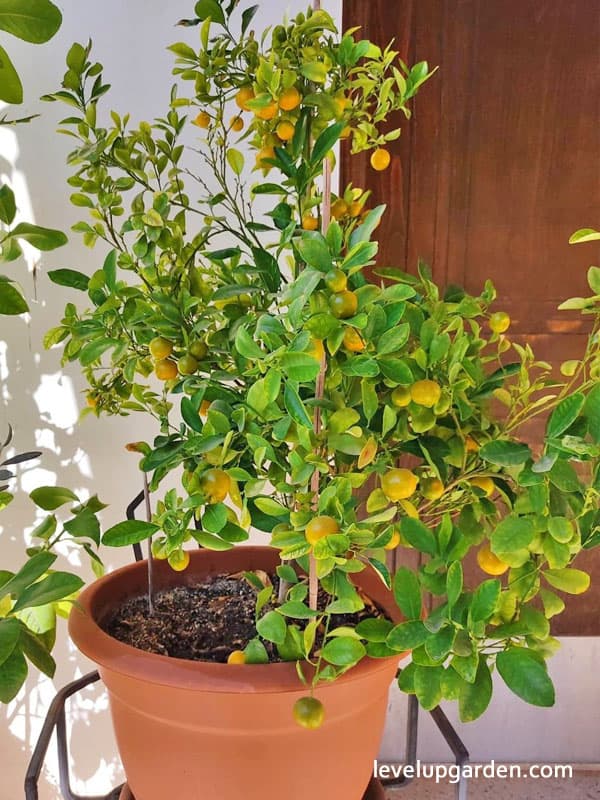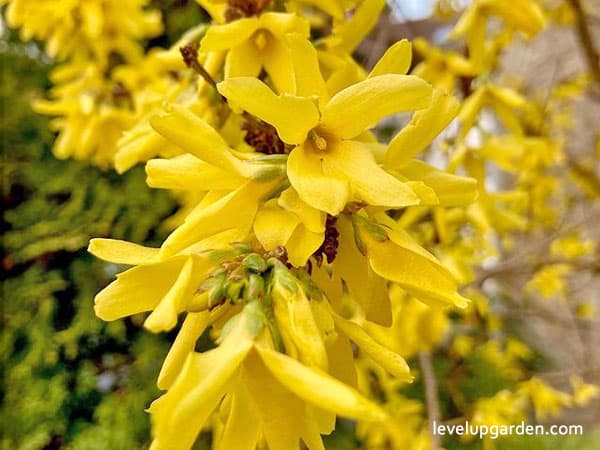Calamondin Tree (Citrus x microcarpa – Calamandarin orange tree) is one of the most popular ornamental citrus species. A close relative of the orange, it bears fragrant white flowers and small oranges. It also produces a large harvest of delicious fruit, and it is one of the most popular potted citrus species.

Often called Citrus mitris, xCitrofortunella microcarpa is now the more correct name. Although called an orange, it tastes like a lemon and can be used like lemon or lime in drinks, fish, pies, and cakes. It also makes an excellent preservative and marmalade.
The Calamondin tree is the perfect tree for those who want to enjoy the beauty of citrus, the sweet fragrance of the flowers, and the colorful fruit, but do not have a very warm area or large space. It grows into a small tree and is hardier than other citrus trees, able to withstand temperatures up to 200 degrees Fahrenheit. It is ideal for planting in pots on a balcony, terrace, or front porch or placing in a sunny spot inside the house during the winter months. The small orange-colored fruits are used like lemons in drinks and cooking, where their unique flavor can be enjoyed.
I. Calamondin Tree Profile – An Overview of the plant
| Common name: | Calamondin, Calamondin Orange, Citrus Calamondin, × Citrofortunella microcarpa, × Citrofortunella mitis, × Citrofortunella mitis ‘Calamondin’, Panama Orange, Philippine Lime, Citrus citrofortunella mitis, Citrus madurensis Calamondin, Citrus × microcarpa Philippine lime, Citrus × mitis ‘Calmondin’ |
| Botanical name: | Citrus x microcarpa, Citrus mitis |
| Native Area: | N/A |
| Plant Family: | Citrus |
| Plant Type: | Fruit, Shrubs |
| Hardiness Zones: | 9-11 (USDA) |
| Mature Height: | 6″ – 10″ |
| Mature Width: | 5″ – 6″ |
| Sunlight: | Full sun |
| Soil Type: | Loam, Sand |
| Soil pH: | Acid, Neutral |
| Soil Drainage: | Moist but Well-Drained |
| Water Needs: | Average |
| Maintenance: | Average |
II. Calamondin Tree Appearance
Calamandarin Orange tree looks like a cross between a tangerine and a kumquat and is usually used in marmalades and baked goods, but more adventurous chefs are discovering different uses for it.
In addition to the natural beauty of the tree’s evergreen foliage, it flowers year-round and yields quite a large crop.

It is prized for its oval, glossy, rich green leaves and very small, round, orange fruits. The orange flesh is sour and juicy and contains a few seeds. The rind is thin, smooth, yellow-orange in color, and can be easily peeled off.
The evergreen leaves are a beautiful glossy dark green and are only 1.5 to 3 inches long. The flowers are large, about 1 inch across, and bloom in small clusters at the tips of the young branches. They are very fragrant and have a beautiful sweet scent.
Fruits are about 15 cm long and green when initially formed. They have a thin, fragrant orange rind and juicy orange flesh with few seeds when ripe. The rind is easily peeled and eaten. The fruit is very juicy and has a lemony acidity. In spring, it produces a profusion of new leaves and flowers, which may bloom every two to three months, and some trees often produce flowers and fruit at the same time.
III. Calamondin Tree Growing and Care Conditions
This tree is humidity tolerant, cold tolerant, and blooms all year round. When planted outdoors, it prefers a warmer location in zones 9 – 11, but this little tree will grow anywhere in the country when potted.

Planting
Choose a sunny location with 6-8 hours of sunlight. Also, make sure the soil is well-drained.
Watering
After watering once or twice a week, water again when the top 2 to 3 inches of soil is completely dry. Try sticking your index finger into the soil to about 2 inches. If there is moisture, hold off watering until it feels dry at that depth. Stop watering when you see water coming out of the drainage hole at the bottom of the pot.
Fertilizer
During the warmer spring and summer months, apply a citrus-specific fertilizer, such as the one included in the Citrus Care Kit, once every six weeks. During the fall and winter, apply fertilizer every two to three months. Be sure to follow the fertilization instructions on the fertilizer bag.
Soil Requirements
In the outdoors, it prefers sandy soils with high organic matter content, but it does well in most soils as long as they are not moist for long periods of time. It prefers full sun but can tolerate some shade.
Pruning
Pruning can be done any time of the year: make cuts at 45-degree angles, remove dead or crossing branches, and thin the tree to allow light to penetrate between branches. After fruiting, remove dead wood, improve ventilation in the center of the tree, and remove suckers growing from the base of the tree.
Pests and Diseases
It is a hardy tree that has few pests and grows with minimal care.
IV. Calamondin Tree Uses
This Calamondin Tree is a very popular houseplant and has made its home everywhere on bright floors and tables.
Calamandarin flowers and bears fruit intermittently throughout the year, adding beautiful color to the shrub with the fragrance of citrus blossoms.
The flowers are self-pollinated and do not require other flower pollination. Calamondin fruits take nearly a year to ripen, so they retain their ornamental value longer than other citrus fruits. The fruits are used in beverages, cakes, pies, jams, sauces, soups, teas, and many other dishes.

Calamandarin is considered a natural hybrid with kumquat as its parent. It is also grown as an ornamental rather than an edible fruit and looks better trimmed as a patio or hedge.
V. Should I buy a Calamondin? Is this the tree for your garden?
Calamandarin orange trees are the easiest citrus trees to grow. It is also ideal if you want to grow citrus but don’t have space in your yard or no yard at all.
This citrus is ideal for growing in pots and can also be grown as a bonsai. It is small and compact when potted, but in the garden, it can grow up to 3 meters tall if left unpruned.

The Calamondin tree can be planted outdoors in mild climates, as long as it is in full sun.
Do you find the ideal tree for your garden?
VI. FAQs
Can you eat a Calamondin orange?
Calamandarins can be eaten whole. These small citrus fruits, about the size of a large cherry, make a great snack. Enjoy its tart citrus flavor in the same way you would a lemon, lime, or orange.
Is it easy to grow Calamondin?
Yes, it is. Calamandarin can be propagated by seeding, rooting from conifer cuttings in the spring or semi-mature cuttings in the summer. It can also be grafted onto sour orange rootstock.
What is Calamondin good for?
Applying calamansi to insect bites cures itching and inflammation. It bleaches freckles and cures acne vulgaris and pruritus vulvae. Administer orally as a cough suppressant and anti-inflammatory. When slightly diluted and warmed, it acts as a laxative.







